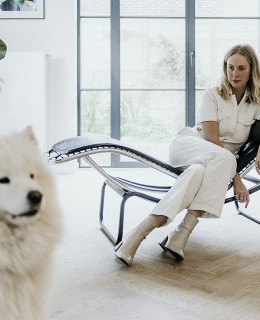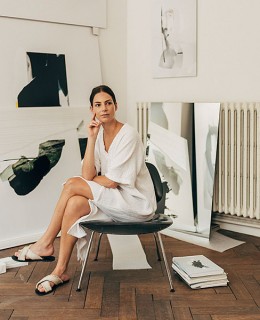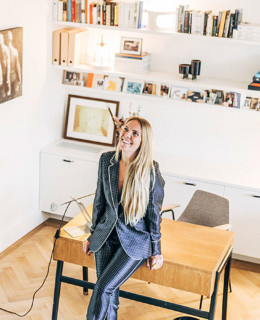“Can you Photoshop my bruised leg, please? I fell off my monobike.”
Conversations with Julie Saverys have always contained a high level of randomness and today is no exception. She’s busy working on her latest obsession, which is to master the art of unicycling, and so far it hasn’t been a success. No biggie, failure isn’t fatal. And she has other badges of honor: those of photographer, graphic designer, deejay and contemporary artist. She’s also my partner in crime, tagging along on all my exploratory travels into Fashion World. While these should lead us to designer ateliers and fashion shows -which occasionally they do- they mostly tend to end up in the weirdest places. Like an overgrow chalet in the middle of a dark wood, both of us running after and feeding goats in the family home of some model we thought was on the verge of a breakthrough. Or going on a very hungover rollerskate tour through Paris because we thought that would get us to fashion shows on time (it didn’t). Or diving in icy water dressed like extraterrestrial penguins because… -well, actually there was no reason àt all to do that. Long story short: put Julie in the mix and things tend to get deliciously out of hand.
Back to business: she is one half of the J&O Saverys project, making vivid artworks based on four set colors: orange, yellow, turquoise and cobalt blue. These distinct shades are the first thing you encounter as you near her sea-front house slash atelier in the city of Knokke-Heist at the Belgian seaside: four neon blocks that seem to have fallen straight out of the sky, joyfully clashing with the natural palette of the surroundings. Confronting said surrounding is part of the house’s legacy, by the way, as it has always held a somewhat isolated place on the historical promenade it stands on.
It was Julie’s great-grandfather, famed painter Albert Saverys, who commissioned the house in 1931 as part of a plan to shake up the seafront -that up until then had only featured English cottage-style houses. His friend and architect Henry Van de Velde, one of the Belgian Art Nouveau greats alongside Victor Horta, masterminded the entire design. The place was conceived as a twin villa, the Noordhinder and Westhinder, and interior-wise both were meant to be a perfect mirror of one another. The pair used the place to gather their band of joyful artist friends and feast on life, art and their own good taste. Contemporaries though, gasped in horror at the bold modernity of the construct. Talking about a bummer. Thus it would be the first and last building of the modern urbanization project to ever see the light. Ironically enough, today it is one of the last remaining single houses on the completely built-up seafront and people would kill for an original Van de Velde house.


The original interior didn’t survive the turmoil of the Second World War, only the living room cupboard and grand fireplace made it, and the house got a brand new inside look by De Coene in the sixties. The latter infused a little dose of mermaid cool, still visible in the amazing spiral staircase and shell-shaped doorknobs.

Nowadays it may be a protected monument and great piece of cultural heritage, but to Julie’s clan it is the family beach house, conceived by great-grandfather Albert as a playhouse and gathering generations of fun-loving descendants. Spending one’s childhood holidays in a place like this, had its catches though. Julie remembers a particularly traumatizing episode for the older generation as her sugar-rushed cousin took his anger for not getting more desert or whatever it was out on the living room door, fists and cutlery and all, smashing holes in the precious material. “God damnit child, doooooooon’t…!”
It got quite loud at times and whoever spends time with Julie has to deal with her customary decibels too, as she not only inherited her ancestor’s artistic streak but also his penchant for partying. The seafront terrace is used to stage her infamous Saverista Beach parties. The garage is turned into both an art studio and mini underground club, where one is served fluorescent green shots between tubes of dried-up Patex glue, unicycles and ironing boards. Julie’s surfboard is never far away either, although I’ve never seen her use it. Her binoculars on the other hand, have a long track record of registering hilarious situations going on in the dunes just opposite Julie’s house. “People really think they are invisible in there, while in fact they might as wel be starring in a show unravelling on a giant screen just in front of me!” She bursts into her signature deafening laughter, the one that has the same effect as a jumbo cappuccino spiced with some suspicious green shot on both your mood and energy level.
“It’s all a bit random, I know.”
























































(pictures by Eva Vlonk)







